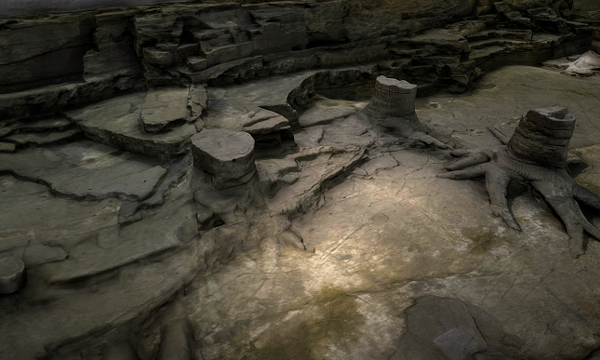Historic Environment Scotland (HES) has today (Mon 11 Mar) published a new 3D digital model of Fossil Grove in Glasgow, allowing users to explore the city’s ancient forest from a unique perspective.
Launched today (Mon 11 Mar) the interactive model, is available to view online via Sketchfab. It has been created through a combination of 3D laser scanning and photogrammetry. This process involves taking hundreds of overlapping images which are then combined to create a 3D model, enabling users to explore the site in detail from a range of different angles.
Fossil Grove, situated in Glasgow’s Victoria Park, is a Site of Special Scientific Interest comprising the spectacular fossilised remains of 11 Carboniferous Lycopod trees, which are around 325 million year old.
The site was discovered in 1887, and has been a popular visitor attraction from the Victorian era to the present day. Fossil Grove is the only site in the world where such trees have been preserved in their growth positions, and is considered one of the world’s first examples of geoconservation.
As well as allowing a new way to explore the site, the digital model will also play an important role in protecting Fossil Grove for the future. HES has been working with The Fossil Grove Trust and Scottish Natural Heritage (SNH) to ensure the long-term conservation of the fossils.
Sarah Hamilton, Conservation Scientist at HES, said:
“Fossil Grove is a unique geological gem, and we’ve been working with partners over the past few years to support efforts to conserve and protect the site with the service and expertise of our Conservation Science and Digital Documentation teams."
“Recently, water penetration into the Victorian building that houses the fossils has caused discolouration and decay to some of the exhibits. We have undertaken 3D laser scanning and mineralogical analysis to help gain a better understanding of the site and these issues."
“As well as being a fantastic tool for interpretation, this new digital model is going to be of huge value to our work at Fossil Grove, as it’s allowing us to access even more detailed base information to create our risk map of the surface condition, which will help inform where we focus conservation efforts.”
Andy MacGregor, SNH Operations Officer, said:
This 3D modelling technology is bringing to life part of Scotland’s prehistory, hundreds of millions of years old. It is an invaluable way to understand our fascinating fossils, and conserve them for generations to come.”
The 3D model of Fossil Grove is available to view on Sketchfab.
Our Conservation Science and Digital Documentation teams are based at the Engine Shed, Scotland’s dedicated building conservation centre.
About Historic Environment Scotland (HES)
- We are the lead public body charged with caring for, protecting and promoting the historic environment. We will lead on delivering Scotland’s first strategy for the historic environment, Our Place in Time.
- Historic Scotland, Scran, Canmore, The National Collection of Aerial Photography (NCAP), The Engine Shed, Stirling Castle and Edinburgh Castle are sub-brands of HES.
- View our press pack and keep up to date by registering for media release email alerts. If you wish to unsubscribe, please contact us.
Follow Historic Environment Scotland
Twitter: @HistEnvScot | @welovehistory
Facebook: @HistoricEnvScotland | @VisitHistoricScotland
Instagram: @HistEnvScot | @historicscotland
For further information, please contact:
Historic Environment Scotland Media Office
Direct line: 0131 668 8714
Mobile: 07468 759 137
communications@hes.scot

